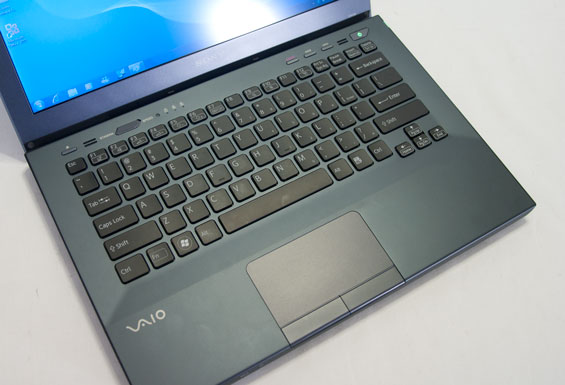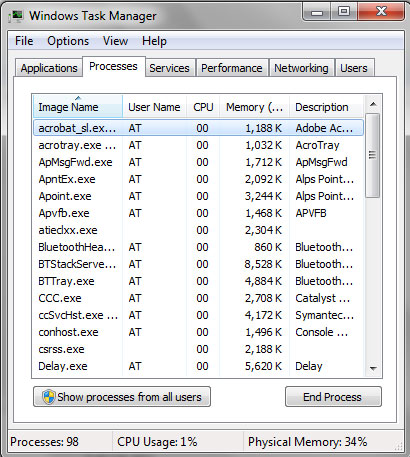Sony VAIO S Series: All Day Consumer Computing
by Dustin Sklavos on September 9, 2011 12:00 AM EST- Posted in
- Laptops
- AMD
- Intel
- Sony
- Sandy Bridge
- 6000M
- VAIO S
- Switchable Graphics
Good Computer, Too Much Bloat
Generally when I've handled these notebook reviews, I haven't gone into the software/bloatware that ships on them too much, if at all. Truth be told, bloatware (at least in my experience) isn't the cancer on the industry that it used to be. These days the worst you have to do is uninstall Norton and disable Bing bar and I'd be hard-pressed to find anyone who thinks that isn't a net win. But before we get to the part where Sony drops the ball with the VAIO S, we'll take a look at the good stuff.
As far as build quality and style go, the VAIO S is primo for a consumer laptop, no doubt about that. Sony uses a combination of aluminum, plastic, and magnesium alloy for the chassis that's extremely attractive, classy, and best of all, functional. There's just no gloss anywhere. And a weight of under four pounds for a powerful 13.3" notebook is really quite good; as far as heft and portability go, it's comparable to a netbook.

The lid appears to be made out of magnesium alloy, as it displays remarkably little flex when you try to twist the screen. From there, the inside surface is brushed aluminum with a recessed, backlit plastic keyboard. My only real complaint as far as the keyboard is concerned is the lack of dedicated document navigation keys, but given the overall thickness (or lack thereof) I'm inclined to let that slide.
Unfortunately the same can't be said for the touchpad. The tracking surface is something that I think is going to divide a lot of end users; some people will really like it, while some people (like me) are just going to find it doesn't feel particularly comfortable to use. Likewise, the mouse buttons feel stiff and require a bit more pressure than I'm used to. The touchpad and buttons probably shouldn't be a dealbreaker for anyone and most users will be able to get used to them, but this is one area where Sony can improve the design of the VAIO S.
Everything else (physically at least) is pretty stellar, though. Above the keyboard is the eject button for the optical drive, next to the "Stamina / Speed" switch. The "Stamina" mode switches off the AMD Radeon HD 6470M and relies on Intel's IGP, while automatically changing the power profile over to "power saver." On the other hand, the "Speed" mode enables the 6470M and switches the power profile over to "high performance." As I mentioned before, Sony appears to be using muxes to handle graphics switching instead of AMD's dynamic switching software solution, and the screen blinks a couple of times (takes about ten seconds) when switching between modes. Thankfully it doesn't require a reboot.
The VAIO S' battery is housed internally, but a single plate on the bottom of the notebook can be removed to swap it out along with changing the hard drive or adding memory to the single DIMM slot. Clearly the battery isn't designed to be hot-swappable, but it doesn't need to be either; there are grooves on the bottom of the notebook the extended sheet style battery latches into.

And then there's this (and then there's Maude?) I actually had my work cut out for me getting the VAIO S into stomping shape for testing, because the factory restored image has a punishing 100 processes running at the outset, which eventually shrinks down to a more reasonable...97? It's really bad. The bloat on the VAIO isn't just the usual bloatware, a tremendous amount of it is Sony's own pack-in crap. Between all of the junk software and the agonizingly slow 5400RPM hard drive, what should be a fairly agile little computer can actually be rendered nigh unusable. I actually had to do the factory restore after I'd started copying over my test suite; Windows Update running in the background was exactly enough to bring the whole system to a crawl, to the point where the mouse pointer lags hopelessly.
Just to put things in perspective: while I'm writing this review on my desktop, I have Photoshop CS5, Windows Live Mail (quiet you), WinAMP, Steam, Trillian, and Firefox open, along with antiviral software, Dropbox, and my UPS system software in the system tray. That brings me up to about 3.6GB of used memory...and 62 processes.
















70 Comments
View All Comments
MacTheSpoon - Friday, September 9, 2011 - link
Thanks for the great review. Any plans to review the Lenovo x220? That's another interesting battery slice computer.Dustin Sklavos - Friday, September 9, 2011 - link
Lenovo kit is still hard to get in house. We'll try, but don't get your hopes up.MacTheSpoon - Friday, September 9, 2011 - link
OK, cool, I'll keep my fingers crossed...GiantPandaMan - Saturday, September 10, 2011 - link
As a happy owner of the x220t (tablet) I'd say that it's a fair bit better. The only bloat comes with the Lenovo software, which is pretty easy to uninstall. I got mine with an SSD so I don't know if the software bloat really caused any slowdown. The screen (IPS) is absolutely excellent. Runs very cool, but it does only have an Intel IGP.The big negatives were:
Touchpad/pointer dying due to a driver conflict with Windows 7 64bit. Had to use my stylus just to get things back running. That's been fixed.
Touchpad is just a tad too wide and a little annoying due to the lack of true left/right click buttons. I actually disabled it entirely because every time I typed I'd end up sliding the cursor by accident and deleting whole paragraphs. Thank goodness for undo.
Difficult ordering. The x220t was paper launched, even though they had it posted on their website. Waited over a month from order date to receive my laptop. Their laptop support people were terrible at knowing what was actually going on. At first they didn't know the difference between the gorilla glass tablet and the normal tablet. Then they didn't know when the gorilla glass tablet would be available. (Found out via twitter rather than their support people.) Then they didn't know what was holding up my laptop when the ship date started changing randomly then going to "unknown" mode. That said, it did ship almost the same time as its original invoiced ship date prediction. I think this may have been more of a specific issue with the x220t though, and not the x220.
As far as I know the ordering issues have been fixed. The x220 is a great piece of hardware. I'm not so sure about Lenovo's support system/people however.
Me, I'm quite happy with my laptop. Great screen. Great battery life. Great keyboard. Tough case/screen with no flex and a solid feel. I fear might happen if I ever have to need to get any repairs on it though.
damianrobertjones - Friday, September 9, 2011 - link
I'm glad that this has been mentioned for once and I hope that the readers realise that MS gets ALL the blame when a computer runs slowHP 5330m: 98 processes
http://forum.notebookreview.com/hp-business-class-...
HP Probook 6460b: 106 processes
http://forum.notebookreview.com/hp-business-class-...
Been there, done that, removed the processes. To Sony & HP: If you want to compete then stop bogging your machines down with absolute rubbish. To Microsoft: Stop the oems destroying YOUR name!
InterClaw - Friday, September 9, 2011 - link
The 14" Samsung Series 7 (NP700Z3A-S01US) feels a lot more interesting to me.zsero - Friday, September 9, 2011 - link
Sorry, all over the internet Sony S is called SA and SB. Can you clarify things a bit?Is this a THIRD model? Or is it an SA or an SB?
They are in different price range (900 EUR vs 1900 EUR), as well as have different screen options (1600x900) and so on. Ideally it would be nice to have a paragraph about the differences in the Sony laptop range, SA, SB, Z, etc. But at least call this arcticle Sony Vaio SB!
For a reference, have a quick look how notebookcheck did it, I know they are a german site, but when there is such a huge difference it would be nice to clarify things a bit.
http://www.notebookcheck.net/Review-Sony-Vaio-VPC-...
http://www.notebookcheck.net/Review-Sony-Vaio-VPC-...
Dustin Sklavos - Friday, September 9, 2011 - link
This is the SB, and there was actually some contention between us as to which model we should refer to this one as.krumme - Friday, September 9, 2011 - link
Another excellent piece from Dustin. Besides the fuent style, i like he present his opinions as what they are - opinions - and not the only objective truth in this world.It is impressive and surprise Sony did work with this machine to get those idle numbers.
The consumers is sure stupid, when they buy those 160 shader gfx, i newer expected that to happen. Why the OEM want to offer it, when it is of no benefit is also a mystery? - thinking long lasting brand loyality...
I think for good measure, every review using the hd3000 should mention the mkv bluray video problem, and quality of the gfx. I take my old 16 cuda 8600m gs over my hd3000 any day. Theese benchmark does not reflect that perception. And i can not be the only one thinking the quality of video and gaming is weak on the Intel. I dont know the technical reason, but the ATI and NV machines, on the same settings, give better picture quality than the hd3000 in fx. TF2. But i doubt that is the reason Sony included the ATI card, or what?
Malih - Friday, September 9, 2011 - link
This review makes me hunger for a 12 inch, or thin 13 inch Laptop with Llano in it. Get out of your a** AMD, get me this Laptop ASAP!!!